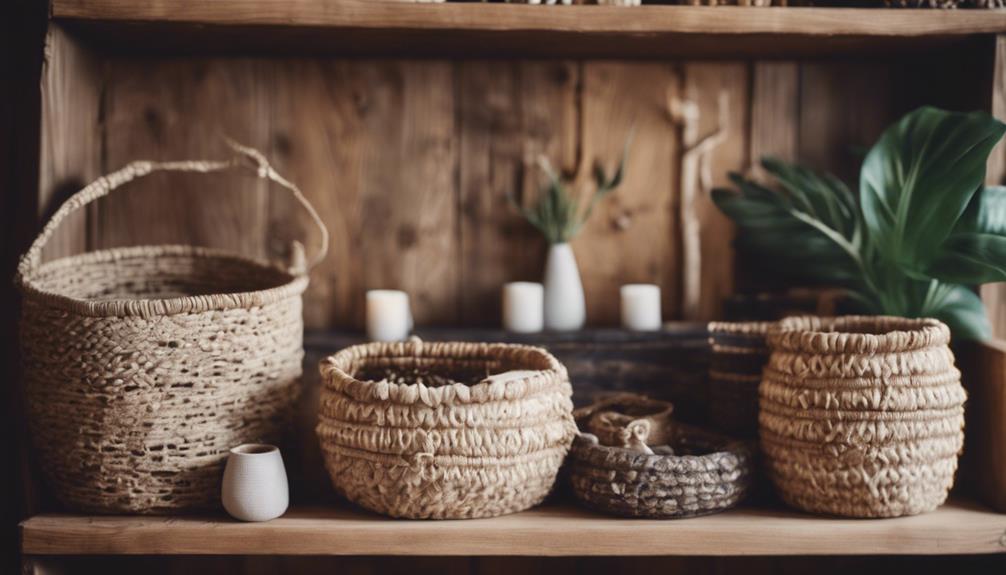If you are considering selling your handmade home decor items online, begin by selecting your niche and creating a captivating website. Highlight your products with beautiful visuals and improve your product photography skills. Set reasonable prices and craft attractive descriptions. Increase your visibility online through SEO and social media marketing. Establish trust with customers by providing top-notch service and professionalism. Keep in mind that mastering these steps is crucial for achieving success with your online business.
Key Takeaways
- Choose a unique niche in handmade home decor.
- Showcase products with high-quality photography.
- Price items competitively based on market research.
- Utilize SEO and social media for marketing.
- Provide exceptional customer service for loyalty.
Choosing Your Niche
Wondering how to pick the perfect niche for your handmade home decor items business? When selecting your niche, consider your own interests, skills, and what sets your products apart.
Start by brainstorming ideas that excite you and align with your creative vision. Reflect on what styles, themes, or materials you enjoy working with the most. This personal connection won't only make your work more fulfilling but also resonate with potential customers seeking authenticity.
Additionally, research current trends and market demands to identify gaps you can fill with your unique offerings. Look for opportunities where your creativity can shine and differentiate your brand from competitors.
Setting up Your Online Store

When setting up your online store, two key points to focus on are choosing a platform and designing your store.
The platform you select will impact how you showcase and sell your handmade home decor items.
Designing your store is essential for creating a visually appealing and user-friendly experience for your customers.
Choosing a Platform
Carefully evaluate the platform where you will set up your online store for selling handmade home decor items. The platform you choose will significantly impact your store's success. Here are some popular platforms to assess:
| Platform | Description |
|---|---|
| Etsy | A well-known marketplace for handmade and vintage items. |
| Shopify | An easy-to-use platform with customizable features. |
| WooCommerce | An open-source plugin for WordPress websites. |
| Big Cartel | Ideal for small businesses with a clean, simple interface. |
| Amazon Handmade | A platform for artisans to sell their handmade goods. |
Each platform has its own set of features, fees, and audience. Take the time to explore each option and choose the one that best fits your needs and goals. Remember to review factors such as ease of use, fees, customization options, and the target audience of the platform. Making an informed decision at this stage will set a strong foundation for your online store's success.
Designing Your Store
To set up your online store successfully for selling handmade home decor items, focus on designing a visually appealing and user-friendly website that showcases your products effectively. Start by choosing a clean and professional layout that highlights your unique creations. Use high-quality images to display your items from multiple angles, providing customers with a clear view of what they're purchasing.
Organize your products into categories and use a simple navigation menu to help visitors easily find what they're looking for. Ensure that your online store is mobile-responsive, as many shoppers browse and make purchases using their smartphones or tablets. Incorporate a secure payment gateway to offer customers a safe and convenient shopping experience.
Include detailed product descriptions, dimensions, materials used, and care instructions to help customers make informed decisions. To wrap up, personalize your store by adding your brand logo, creating a cohesive color scheme, and writing a compelling 'About Us' page to connect with your audience on a more personal level.
Showcasing Your Products Effectively

When showcasing your handmade home decor items online, remember to utilize visual merchandising tips and product photography tricks.
These techniques can help attract potential customers and highlight the unique features of your products.
Visual Merchandising Tips
Improve the presentation of your handmade home decor items by mastering visual merchandising techniques that effectively showcase your products.
When setting up your online store, consider creating a cohesive theme that reflects your brand and the style of your products. Utilize high-quality images that highlight the unique features of each item. Organize your products into categories, making it easy for customers to navigate and find what they're looking for.
Utilize descriptive titles and detailed product descriptions to provide customers with all the necessary information. Use keywords that are relevant to your products to improve searchability. Implement a clean and uncluttered layout that allows your products to stand out.
Consider using lifestyle images to show your products in use, helping customers envision how they could incorporate them into their own spaces. Experiment with different display techniques such as grouping complementary items together or showcasing a single standout piece.
Utilize visual elements like color coordination and varying heights to create an aesthetically pleasing display. Remember, effective visual merchandising can make a significant impact on your online sales.
Product Photography Tricks
Capture the essence of your handmade home decor items through strategic product photography techniques. To showcase your products effectively, start by using natural light to highlight details and textures. Position your items near a window or outside for soft, even lighting that enhances the beauty of your creations. Experiment with different angles to find the most flattering perspectives for each piece. Close-up shots can emphasize intricate designs, while wide shots provide context and show how your items can enhance a space.
Consider using props to create visually appealing compositions that tell a story about your products. Incorporate elements like plants, books, or decorative accents to add depth and interest to your photos. Keep backgrounds simple and uncluttered to draw focus to your handmade items. Use editing tools to enhance colors, sharpness, and overall quality, but avoid over-editing to maintain the authenticity of your products.
Pricing Your Handmade Items

To effectively price your handmade items, consider the cost of materials and the time spent creating each piece. Calculating the cost of materials involves adding up the expenses for all the components used in making your home decor items. This includes everything from fabrics and paints to embellishments and hardware. Don't forget to account for packaging materials and shipping costs if applicable.
Time is another significant factor in pricing your items. Determine how many hours it takes to create each piece and decide on an hourly rate that reflects your skill level and the effort put into your work.
After calculating these costs, add them together to determine the base price for each item. To make sure you make a profit, consider adding a markup percentage to cover overhead expenses and provide you with a reasonable income.
Research similar products online to get an idea of market prices and adjust your pricing accordingly to stay competitive while still valuing your time and craftsmanship. Remember, pricing your handmade items fairly will help you attract customers and build a successful online business.
Crafting Compelling Product Descriptions

Crafting impactful product descriptions for your handmade home decor items is essential for attracting potential buyers and showcasing the unique qualities of your creations. When writing descriptions, focus on highlighting the materials used, the craftsmanship involved, and the aesthetic appeal of your items. Use descriptive language that evokes emotions and paints a vivid picture for your customers.
Here is a helpful table to guide you in crafting compelling product descriptions:
| Feature | Example |
|---|---|
| Material | Handwoven rattan basket |
| Craftsmanship | Intricately hand-painted vase |
| Aesthetic Appeal | Bohemian-inspired macrame wall hanging |
| Functionality | Multi-functional wooden storage crate |
| Unique Selling Point | One-of-a-kind vintage ceramic lamp |
Capturing High-Quality Product Photos

When capturing high-quality product photos for your handmade home decor items, consider the importance of proper lighting, background choices, and composition.
Lighting can make a significant difference in the clarity and appeal of your product images, while the background and composition help highlight the uniqueness of your creations.
Lighting for Product Photos
For capturing high-quality product photos of your handmade home decor items, proper lighting is essential. Adequate lighting helps to showcase the details, colors, and textures of your products accurately. When setting up your photo shoot, natural light is often the best option. Position your items near a large window or in a well-lit room to take advantage of the soft, diffused light that enhances the overall look of your products.
If natural light isn't available or consistent, consider investing in artificial lighting sources. Softbox lights or ring lights can help create a well-lit environment that mimics natural light. Make sure the lighting is even across your products to avoid harsh shadows or overexposed areas.
Experiment with different angles and intensities of light to find the most flattering look for your items. Keep in mind that the goal is to accurately represent your products, so avoid overly bright or dim lighting that distorts their appearance.
Background and Composition
To capture high-quality product photos of your handmade home decor items, pay attention to the background and composition of your shots. The background and composition play a pivotal role in highlighting the beauty and uniqueness of your creations. Here are some tips to enhance your product photos:
| Background | Composition |
|---|---|
| Choose a clean, simple background that doesn't distract from your item. | Experiment with different angles and perspectives to showcase various features of your decor. |
| Use props sparingly to complement your item without overpowering it. | Utilize the rule of thirds to create visually appealing and balanced images. |
| Consider using textured backgrounds or interesting surfaces to add depth to your photos. | Pay attention to lighting to enhance the details and colors of your decor. |
Implementing SEO Strategies

Boost your online visibility by incorporating effective SEO strategies when selling handmade home decor items. To begin, conduct keyword research to identify popular search terms related to your products. Integrate these keywords naturally into your product titles, descriptions, and tags to improve your chances of appearing in relevant search results.
Optimize your website by ensuring it loads quickly, is mobile-friendly, and has clear navigation. Search engines favor websites that offer a seamless user experience. Additionally, create unique and engaging content such as blog posts or product descriptions that incorporate relevant keywords. Regularly updating your content can also enhance your SEO rankings.
Utilize meta tags and alt text for images to provide search engines with more information about your products. This helps improve your chances of appearing in image search results.
Consider reaching out to influencers or bloggers in the home decor niche to generate backlinks to your website, which can significantly enhance your search engine rankings.
Leveraging Social Media Marketing

Improve your online presence and engage with a wider audience by strategically leveraging social media marketing for your handmade home decor items. Social media platforms offer a powerful way to showcase your unique creations and connect with potential customers. Here are some key tips to effectively use social media for promoting your handmade home decor items:
| Tip | Description |
|---|---|
| Create Stunning Visual Content | Share high-quality images and videos of your handmade decor pieces to grab attention. |
| Engage with Your Audience | Interact with followers by responding to comments, hosting giveaways, and running polls. |
| Collaborate with Influencers | Partner with influencers or bloggers in the home decor niche to reach a larger audience. |
Building Customer Trust and Loyalty

Enhancing customer trust and loyalty is essential for the sustained success of your handmade home decor business. To build trust, make sure that your online store and social media platforms are professional, up-to-date, and user-friendly. Transparency in your product descriptions, pricing, and shipping policies goes a long way in establishing credibility with your customers.
Offering exceptional customer service and promptly addressing any concerns or inquiries can help foster loyalty among your clientele. Personalize interactions by thanking customers for their purchases and following up to confirm their satisfaction. Providing a seamless shopping experience, from browsing your products to receiving their orders, will encourage customers to return and recommend your business to others.
Encourage feedback and reviews from satisfied customers to showcase the quality and reliability of your handmade home decor items. Incorporating customer testimonials on your website can further build trust with potential buyers. By consistently delivering on your commitments and exceeding customer expectations, you can cultivate a loyal following that will support your business for years to come.
Providing Excellent Customer Service

To guarantee customer satisfaction and foster loyalty, prioritize providing exceptional service in every interaction with your handmade home decor business. Promptly respond to customer inquiries and messages to show that you value their time and interest. Be courteous and professional in all communications, whether through emails, social media, or your online store. Make sure to address any concerns or issues promptly and effectively, showing genuine care for your customers' experiences.
Offer personalized assistance to customers by helping them choose the right home decor items for their needs or providing recommendations based on their preferences. Going the extra mile can leave a lasting impression and encourage repeat business.
Ensure that your shipping and delivery processes are efficient and reliable. Provide accurate tracking information and keep customers updated on the status of their orders. In case of any delays or problems, communicate transparently and offer solutions to resolve the issue promptly.
Frequently Asked Questions
How Can I Protect My Designs From Being Copied by Competitors?
So you're worried about competitors copying your designs? Well, keep your creations under wraps until they're ready to launch. Consider trademarking or copyrighting your work for added protection. Stay creative, but cautious!
Is It Better to Sell on Multiple Online Platforms or Focus on One?
When deciding whether to sell on multiple online platforms or focus on one, consider your bandwidth and marketing efforts. Starting with one platform allows you to focus and build a strong presence before expanding.
What Is the Best Way to Handle Returns and Exchanges for Handmade Items?
Handle returns and exchanges for handmade items with clear policies. Communicate them on your website and in order confirmations. Promptly respond to inquiries and process requests efficiently, maintaining customer satisfaction and trust in your brand.
How Can I Effectively Manage Inventory and Avoid Overselling?
To effectively manage inventory and avoid overselling, you should regularly update your online listings, use inventory management tools, set alerts for low stock, and implement a system to track sales in real-time.
Should I Offer Custom or Personalized Options for My Handmade Products?
When deciding whether to offer custom or personalized options for your handmade products, consider your target market's preferences and the potential for increased customer satisfaction and loyalty. Personalization can set you apart.
Can I Sell Handmade Home Decor Items Online to Make Money from Decluttering?
Yes, you can definitely sell home decor for profit online. There is a demand for unique handmade items, especially in the home decor niche. By decluttering your space and creating beautiful handmade decor items, you can make money while also reducing clutter in your home.
Conclusion
Congratulations on taking the first steps to becoming an online handmade home decor entrepreneur!
Remember, in this saturated market, it's important to stand out by being authentic and genuine with your products and marketing strategies.
Don't fall into the trap of generic trends or sacrificing quality for quantity.
Stay true to your craft and your customers will appreciate the heart and soul you put into each handmade treasure.
Good luck on your creative journey!









